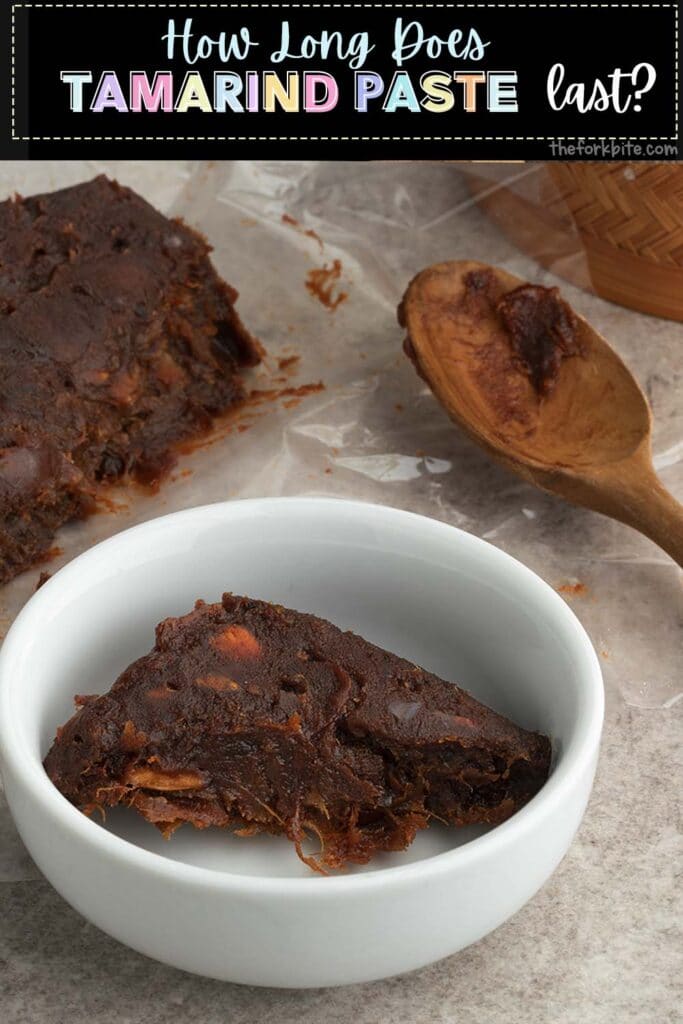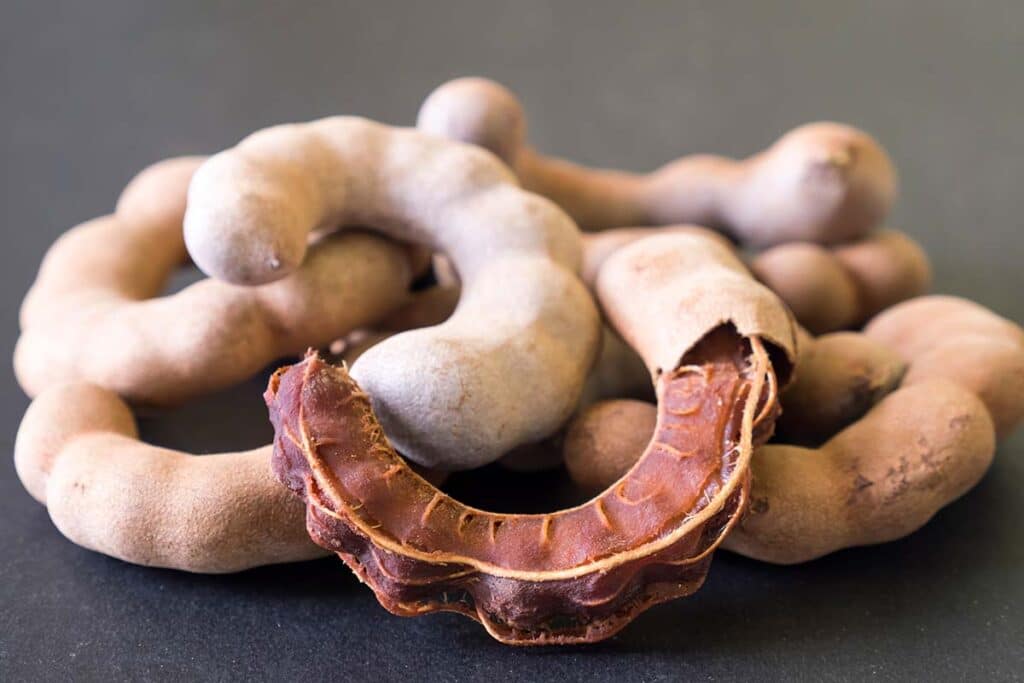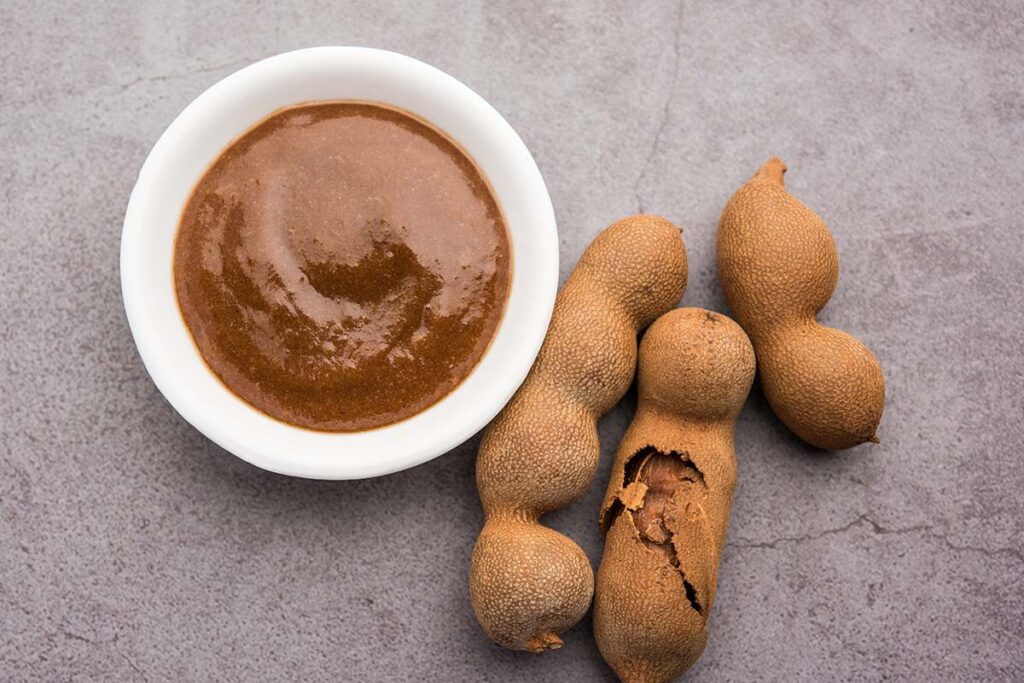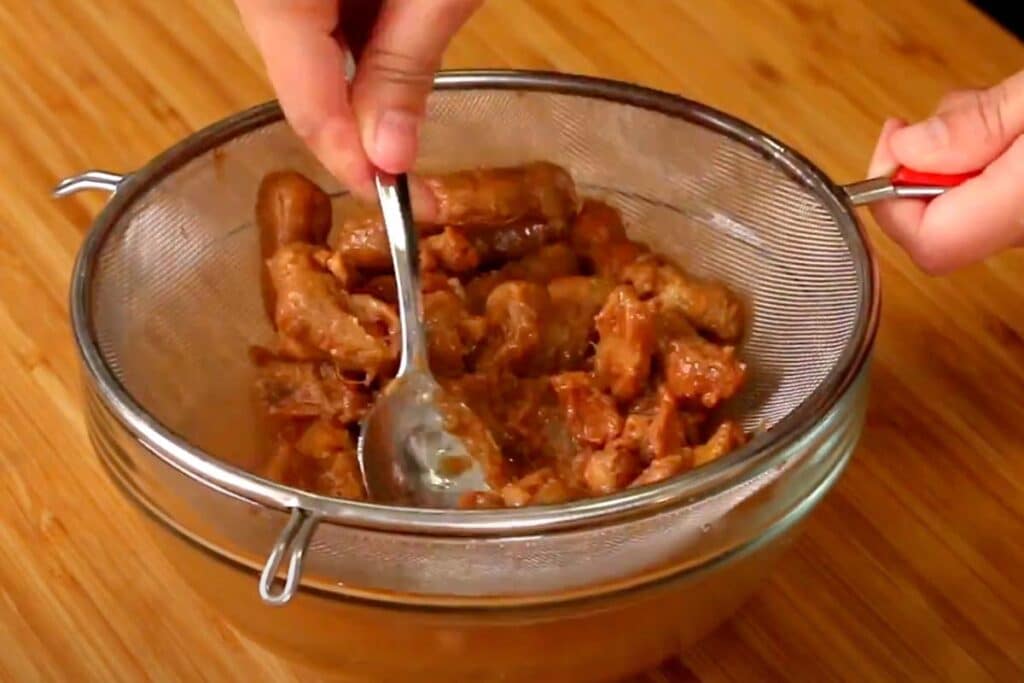If you want to learn how not to waste tamarind by understanding how best to store it, you are in the right place. All you have to do is read on.
I will explain all there is to know about this product, including how to use it and extend its shelf-life.
Tamarind pods come from the tamarind tree, a native of Africa and found in India and Pakistan. Indians usually grind these pods into a paste and then flavor dressings, beverages, and sauces.
As well as paste, tamarind can also be found compressed and in syrup form.
Knowing how to store them properly will mean you can have some on hand when you need them.

More about Tamarind
The tamarind used in cooking is harvested from the gooey pulp surrounding the seeds inside a tamarind pod.
Other names for tamarind are tamarindo and Indian date. It contains a high concentration of tartaric acid, which imparts a sharp, sweet-and-sour taste to the concoctions to which it is added.
It's the sort of flavor hit that makes your taste buds wake up and take notice.
As well as Africa, India, and Pakistan, tamarind also grows in other South-Eastern Asian countries and the West Indies.
The name "tamarind" is derived from the Arabic, "Tamar hind," which means "Indian dates."
If like me, you're a fan of Indian curry, you have probably already consumed tamarind, although you may not know it.
It is also frequently used in Indian chutneys and several Middle-Eastern dishes, and African and Mexican cuisine.
Tamarind also has several health benefits, as per this article on the healthline.com website.
About tamarind paste
Tamarind paste is made from the dark reddish-brown flesh that surrounds the seeds inside a tamarind pod.
Once extracted and separated from the seeds, you can immerse this flesh in hot water for around 30 minutes.
Then pass through a sieve to remove any fibrous threads and seeds you may have inadvertently extracted with the reddy-brown flesh.
The flavor of tamarind paste
As mentioned above, the flavor of tamarind paste is sweet and sour with a sharp tanginess. The flavor combination changes slightly depending on the other ingredients used.
It also has a certain smokiness and a hint of caramel hidden in its taste, giving it a unique flavor profile. As regards consistency, it is thick and gooey and looks somewhat like molasses.
The overall flavor is bitterness, but you can compensate for the sharpness by adding a little sugar.
The ripeness of the fruit also has a bearing on the taste of the paste. When the fruit is less ripe, the taste is more bitter. It sweetens as the fruit matures and ripens.

How long does tamarind paste last?
The instructions on most jars or containers of tamarind paste recommend storing it in a cool, dry place such as a dark kitchen cupboard or pantry.
But people who cook with tamarind paste regularly prefer to store it in a refrigerator, giving it a considerably longer shelf life and helps to maintain its fresh taste.
When refrigerated, it does become quite thick; therefore, before using it is may be necessary to dilute it with a little water.
After use, you need to make sure to reseal the container, which will lengthen its shelf-life.

How to store whole tamarind pods
- Transfer the pods into a Ziploc bag
- Suck out as much air as you can, then seal. You can remove excess air by zipping closed the zip lock bag but leaving one small corner open.
- Insert a straw, suck out the air, then withdraw the straw and immediately complete the sealing of the bag. Air extraction is made even easier if you have a vacuum sealer.
When packaged in this way, tamarind pods will remain good at room temperature almost indefinitely.
Best way to store concentrated or compressed tamarind
- Unopened jars of concentrated tamarind paste can be kept in a kitchen cupboard or pantry for many months - even years.
- Opened jars or containers of tamarind store concentrate should be placed in airtight containers or Ziploc bags with as much air removed as possible and then refrigerated. They will be good for up to 3 months.
- If you buy compressed tamarind in block form, the best way to store it until you need it is in your freezer. If the bag is unopened, transfer it as it is into the freezer.
- Once the package has been opened, any leftovers should be transferred to a Ziploc bag and frozen.
Does tamarind paste go bad?
I use tamarind constantly, and I have kept unopened jars of the stuff for up to 2 years. When I open them, I always check to ensure that no mold has grown in the interim.
I usually make my own tamarind, so I prefer to buy it in block form as it is easy to wrap and store at length at room temperature.
If I am storing tamarind paste or juice, then I always keep it in the fridge.

Making your own tamarind paste
Wherever possible, I like to make my own things rather than using shop-bought products, and such is the case with tamarind paste.
It's pretty straightforward, and you can start by buying tamarind pods in dried form from Asian grocery stores, selected supermarkets, or online from places like Amazon.
You first need to extract the pulp or juice from the pods, which you can do in 1 of 3 ways.
Method 1 - Traditional
- Tear a small piece of tamarind away from the block and immerse in warm water for approximately 10 minutes until fully softened.
- Squeeze with your fingertips to extract as much "juice" as you can, then strain.
- Discard any pulp.
Method 2 - Unconventional
- Tear as much tamarind as you need from the block and transfer into a glass container.
- Completely cover it with water, seal the container, and refrigerate overnight. In the morning, it will be soft and ready to go.
- Remove the softened tamarind from the water, and squeeze out as much juice as you need. You can return any leftovers to the jar of water. The jar is resealed and returned to the fridge, where it will be good for anything for one week.
Method 3 - the best way
As I said earlier, I use tamarind, so making my own tamarind paste comes naturally.
Follow this method, and you can always have tamarind juice in your fridge which will be okay for a week or more.
The best way I have found to extract the juice from the pulp is to use your hands. But doing so introduces bacteria which can affect how long it will be before it starts to turn.
That's why the next thing I do is to boil it. It kills off the germs and prolongs the shelf-life of the tamarind juice.
I always make my juice in bulk as it is not something I want to be doing every five minutes.
1 Place 5 to 6 ounces of tamarind into a microwave-safe bowl along with 2 cups of water; this is enough to make approximately three cups of juice.

2 Position the bowl in the microwave and blast on full power for approximately one minute until it softens. Allow it to cool.
3 Using a spoon or your fingers, squeeze as much juice as you can from the pulp. Pass the mixture through a sieve.

4 Add a little more water and repeat. I find I usually use about one cup of water in this final process.
5 Don't add too much water, or your juice will be over-diluted. If this happens, it will mean that you have to use an awful lot more of the juice in the dishes you are making to get the desired result.

You do need to put everything you've got into the juicing.
6 Once you finished, discard the leftover pulp and seeds. Transfer the liquid into a saucepan and boil it on your stovetop for a couple of minutes.
7 Turn down the heat and let it simmer for a further five minutes until it begins to thicken, then take it off the heat so it can cool.
8 Transfer the juice into a hygienically clean jar and refrigerate. When you use your juice, take out what you need using a clean and dry spoon to avoid contaminating the juice left in the jar.
9 Reseal the jar and return it to the fridge, which will be good for up to 3 months. Alternatively, you can pour the juice into ice cube-making trays and freeze it if you want to keep it for longer.
Where to buy tamarind paste?
Tamarind paste is usually sold either in plastic containers or glass jars. It is highly concentrated, so one jar will last a considerable time.
As I mentioned earlier, you can purchase it in most Asian grocery stores and Indian food stores in particular.
Some supermarkets also stop it, but if you're stuck, you can always buy it online.
Substitute for tamarind paste
The flavor of tamarind is a combination of sweet and sour all in one.
If you come to use it and discover you don't have any, don't panic. There are alternatives you can fall back on.
They all involve combining several ingredients that will give you something like the flavor you seek.
Option 1 - Worcestershire sauce plus
Some Worcestershire sauces contain tamarind as ingredients, which gets you off on the right foot.
To get the flavor you need, you must add brown sugar, lemon juice, tomato paste, and water.
You will need:
- 2 tablespoon brown sugar
- 3 tablespoon lemon juice
- ½ cup tomato paste
- 2 tbps water
- 3 tablespoon Worcestershire sauce
If possible, you should use fresh lemon juice rather than the bottled variety. It gives the final product a better flavor.
If you don't have either, you can resort to using lime or apple cider vinegar.
Option 2 - pomegranate molasses
If you don't have any Worcestershire sauce around, then pomegranate molasses is your next best bet. It is a viscous dark syrup made by reducing down pomegranate juice.
It will give you the sweet, sour combination you're looking for with a sour and bitter undertaste.
It's ideal for use in Asian and Indian cuisine.
If you're going to use this as an alternative to tamarind paste, do so in equal quantities.
Option 3 - Lime juice with brown sugar
This is a rather handy alternative because it's likely you will have the ingredients at home.
The lime juice gives you that hint of sharpness you're looking for, while the sugar provides a nice sweet counter.
You won't get the same flavor complexity with tamarind paste, but depending on the dish you use, many people will not even realize it.
- Quantity-wise, this swap works on a one-to-one ratio, so if your recipe says one tablespoon of tamarind, replace it with one tablespoon of this lime and brown sugar mixture.
Option 4 - Dried fruit plus lemon juice
The dried fruits of this alternative are apricots, dates, and prunes. After being chopped into small pieces, lemon juice and water are added.
The proportions are as follows:
- 1 teaspoon dried apricot
- 1 teaspoon dried dates
- 1 teaspoon dried prunes
- 1 teaspoon lemon juice
- 1 small bowl of water
Mix everything, cover the bowl and wait for 20 to 30 minutes for the dried fruit to soften. Then strain and blend.
Although the texture is tamarind-like, the taste is similar but not as sharp.
If you haven't got any apricots, dates, or prunes, you can use raisins instead.
The proportions shown above will give you about one and a half tablespoons. If you need more, increase the amount of ingredients proportionately.
Option 5 - Rice vinegar
- Rice vinegar plus brown sugar can also be used as an alternative to tamarind.
- If you don't have any rice vinegar, you can use white wine vinegar instead.
- The ratio is one to one.
Useful tip:
Don’t use cheap vinegar. It tends to be too sharp and will overpower the other flavors of the dish. Use in the same quantity as you would tamarind.
Option 6 - Marmalade
The citrus flavor of good marmalade isn't close to tamarind's, but it has an astringency that will do the job.
Again, use it in the same proportion.
Option 7 - Amchur powder
You may not be familiar with Amchur powder, but it is popular in North India.
It is made from unripe mango, which is chopped, dried, and ground into a powder.
When mixed with water in equal quantity, it will give you a fruity, sharp, and sour flavor similar to tamarind.
Swap it for tamarind on a one-to-one ratio.
Option 8 - Tamarind pulp
The most likely place to buy this is in an Asian grocery store or online. It is what is used to make tamarind paste.
If the product you purchase has seeds in it, you should remove them first.
Here's what to do:
- Mix two tablespoons of the pulp with half a cup of lukewarm water and leave to soften.
- Rub the softened pup between your fingers to turn into a paste.
- If you spot any seeds, remove them.
- Strain to get rid of the water.
Ways to use tamarind in cooking
Because it has such a robust flavor, only use tamarind paste in small amounts.
You can cook with tamarind paste in many ways.
1
You can add it to sweet condiments like chutney to bring a hint of bitterness.
2
You can use it to tenderize meat. If you have a relatively tough cut of beef, for example, coat the outside with tamarind paste and leave to marinate.
3
It is used extensively in curries and other spicy dishes. The Indians often mix tamarind with coconut or coconut milk to offset some of the paste's sourness.
It's a common ingredient in many curry dishes, Pad Thai sauce, coriander, garam masala, ginger and turmeric.
4
Although it may be an acquired taste, you can eat tamarind seeds. In Caribbean countries, they are roasted and eaten as a snack or ground up and used in Indian cake mixes.
5
Tamarind is an essential ingredient of Pad Thai together with fish sauce, sugar, and vinegar.
6
Tamarind paste can also be used as the main ingredient, although you may want to combine it with sugar to dial down its bitter taste.
Tamarind flesh is also used to make tamarind balls -- a sweet delicacy enjoyed on many Caribbean islands.
How do tamarind concentrate and tamarind paste differ?
The prime difference between tamarind paste and tamarind concentrate is the strength of flavor.
As the name suggests, the concentrate has been concentrated directly from the fruit.
Tamarind paste is made from the flesh of the fruit, which has a date-like texture.
Because it's not concentrated, it is milder in flavor than the concentrated version.
You can buy tamarind concentrate in small plastic containers.
How tamarind paste or concentrate differs from tamarind pulp
Tamarind concentrate or paste is made from tamarind pulp. It is sold wrapped in plastic.
You can find out more about how to make your own paste from pulp on the kitchn.com website. Essentially you soak the pulp to soften it and then pass it through a sieve.
Tips when cooking with tamarind paste
You use tamarind paste straight from the jar or container in which you bought it.
It is very sour, so you will need to add as much sugar to suit depending on your palate.
In the right proportions, it brings a delicious sweet and sour taste to the dishes to which it is added.
You will find that the consistency and strength of flavor vary from brand to brand, so you may need to do some testing.
But when you find the right one, it will have been well worth the hassle.




